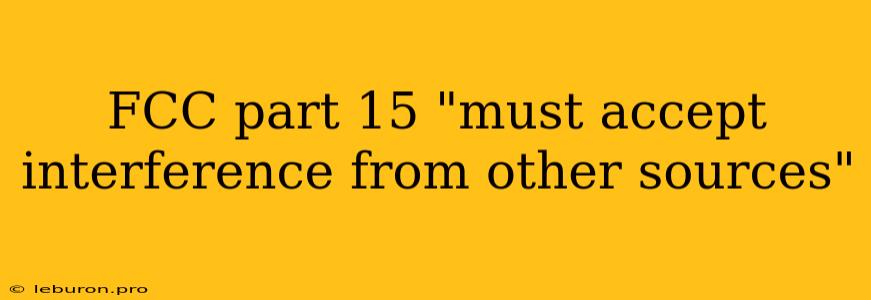The realm of wireless communication is vast and ever-evolving, with devices constantly vying for space on the electromagnetic spectrum. To ensure a harmonious coexistence, regulatory bodies like the Federal Communications Commission (FCC) in the United States have established rules and guidelines for the operation of radio frequency (RF) devices. One of the fundamental principles enshrined in these regulations is the "must accept interference from other sources" clause, a crucial element that fosters compatibility and prevents the disruption of essential wireless services. This article delves into the significance of this principle, exploring its implications for device manufacturers, users, and the overall wireless ecosystem.
Understanding the "Must Accept Interference" Principle
The "must accept interference from other sources" principle, often referred to as the "interference tolerance" principle, is a cornerstone of FCC Part 15 regulations. It mandates that any device operating under these rules must be designed and manufactured to withstand interference from other legitimate RF sources operating within the same frequency band. This principle is not a blanket exemption from all interference; rather, it sets a practical standard for acceptable levels of interference that devices must tolerate without compromising their intended functionality.
H3. The Rationale Behind Interference Tolerance
The rationale behind this principle is straightforward: the radio frequency spectrum is a shared resource, and numerous devices, from cell phones to Wi-Fi routers to Bluetooth headsets, rely on it for communication. Without interference tolerance, every device would have to operate at extremely low power levels to avoid affecting others, effectively hindering the development and deployment of wireless technologies. By allowing devices to accept a certain level of interference, the FCC promotes a more efficient and dynamic wireless environment.
H3. Types of Interference
Interference can manifest in various forms, each posing different challenges to device operation. Some common types include:
- Co-channel interference: Occurs when two devices operating on the same frequency channel interfere with each other.
- Adjacent-channel interference: Occurs when devices operating on adjacent channels create interference due to spectral overlap.
- Spurious emissions: Unintended radio frequency signals emanating from a device that can interfere with other devices.
- Harmonic interference: Occurs when a device's fundamental operating frequency generates harmonic frequencies that fall within the spectrum used by other devices.
The Impact of "Must Accept Interference" on Device Manufacturers
The "must accept interference from other sources" principle places a significant responsibility on device manufacturers. They must:
- Design devices with robust interference rejection capabilities: Devices must be equipped with filters, shielding, and other techniques to minimize the impact of interference from other sources.
- Comply with FCC Part 15 testing requirements: Devices must undergo rigorous testing to ensure their compliance with interference tolerance standards.
- Provide documentation and user instructions: Manufacturers must provide users with clear information on potential interference sources and mitigation strategies.
H3. The Importance of Proper Device Selection
For users, understanding the "must accept interference" principle helps them make informed decisions regarding device selection. Factors to consider include:
- Operating frequency band: Devices operating in crowded frequency bands, such as 2.4 GHz for Wi-Fi, are more susceptible to interference.
- Interference rejection capabilities: Devices with better interference rejection capabilities are more likely to function reliably in challenging RF environments.
- Compatibility with other devices: Choosing devices compatible with each other can minimize interference issues.
The "Must Accept Interference" Principle in Action
The "must accept interference from other sources" principle is not merely a theoretical concept but a practical reality that impacts everyday wireless experiences. Here are some examples:
- Wi-Fi connectivity: In crowded Wi-Fi environments, such as apartment buildings or public spaces, interference from other Wi-Fi networks and Bluetooth devices can affect signal strength and network performance. Devices with strong interference rejection capabilities can mitigate these issues.
- Bluetooth audio: Bluetooth headsets can be susceptible to interference from other Bluetooth devices, leading to dropped calls or audio glitches. Selecting devices with advanced interference-mitigation techniques can minimize these problems.
- Radio communication: Amateur radio operators often encounter interference from nearby devices, such as microwave ovens or electronic equipment. The "must accept interference" principle helps ensure that they can continue their hobby without unduly disrupting other wireless services.
Conclusion
The "must accept interference from other sources" principle is a critical element in maintaining a stable and efficient wireless ecosystem. By requiring devices to tolerate a certain level of interference, the FCC encourages innovation, promotes compatibility, and safeguards the interests of all wireless users. While interference can be a nuisance, it is an inherent part of the wireless world, and accepting this principle is essential for the seamless operation of our increasingly connected society. As technology continues to evolve, the principle of "must accept interference from other sources" will remain a guiding principle, shaping the future of wireless communication and ensuring its continued growth and development.
